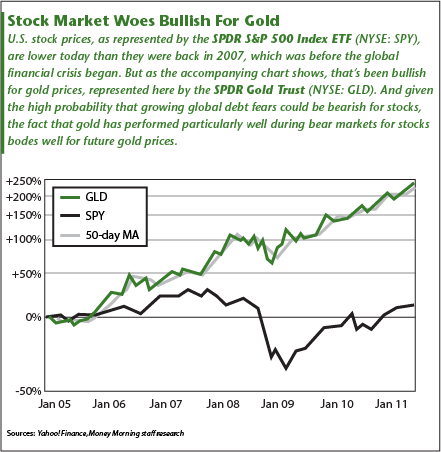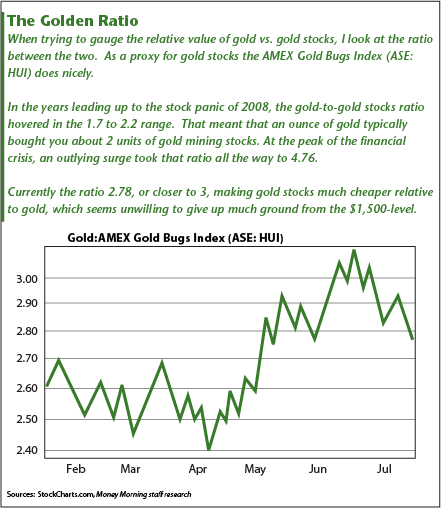By Peter Krauth
The yellow metal has risen steadily since the start of 2009, when it was trading at a bit less than $900 an ounce.
And gold's advance has accelerated of late. The price of gold increased 21% in the year's first half. And even with the decline to $1,587.30 yesterday (Tuesday), the yellow metal is up 7% since July 1.
Many investors and investment pundits are claiming this gold-plated party is destined to end: When the Eurozone gets its house in order and our elected leaders in Washington finally reach a federal budget accord, these gloom-and-doomers say the price of gold will plummet.
But I say they're wrong.
Gold isn't going to crash. In fact, it isn't even going to hold steady at current levels.
The price of gold is destined to soar during the next six months to nine months.
And I'm going to show you the best way to hitch a ride on this rocket.
The Bright Side to Global Debt Fears
I've been analyzing gold miners and other natural-resources investments for a long time. Now, when I'm analyzing precious-metals-related investments for a Money Morning column, or for the subscribers of my "Global Resource Alert" trading service, there are certain financial indices that I like to study. And I especially like to see how each of these indices behaves against one another.
And as the accompanying chart demonstrates, this woeful period for U.S. shareholders has been very bullish for gold investors.
Even more interesting - and bullish - is how gold has reacted to bear-market moves for stocks: During the most-sizeable share sell-offs, we saw strong surges in the price of gold.
Why is that bullish?
It's actually quite simple.
Governments around the world have taken on massive amounts of debt. That's not a problem that can be solved overnight. And the longer it takes to fix, the greater the odds that we'll see a sovereign-debt default whose fallout will be far greater than anyone now expects.
As we saw Monday, just the fear of a sovereign-debt default was enough to tip stocks into a nosedive.
And any such nosedive will clearly be good for the price of gold, which will power higher in the very midst of sizeable stock sell-offs.

In the very near term, if governments are able to allay debt fears, we could see a period of "consolidation" for gold prices. But there's no way to eradicate all this debt in a short period of time. That means this issue will resurface again and again.
So long-term, the global-sovereign-debt crisis will be very bullish for gold.
As we saw, there's a relationship between stock prices and the price of gold that gives us a way to predict just where the "yellow metal" may be headed.
In my years as a natural-resources analyst, I've come across several other value measures, which I've also put to good use. One of my other favorites is a useful ratio that can be calculated by comparing the relative value of gold versus gold stocks.
And this ratio tells us that gold stocks are currently a very compelling value.
Let me show you why.
The Looming Surge in the Price of Gold
As a proxy for gold stocks, the AMEX Gold Bugs Index (AMEX: HUI) does nicely.In the years leading up to the stock-market panic of 2008-09, the gold-to-gold stocks ratio hovered in a range of 1.7 to 2.2. That meant that an ounce of gold typically bought you about two units of gold-mining stocks. At the peak of the financial crisis, an outlying surge took that ratio all the way to 4.76. Essentially, the bear-market sell-off made gold stocks very cheap on a historical basis relative to gold. And that set up a tremendous buying opportunity.
In fact, it was the best buying opportunity since this secular bull was launched in 2000.
But here's where it gets really interesting. After bottoming in April, the Gold/HUI ratio surged up to 3.0, making gold stocks much cheaper relative to gold, which has been unwilling to give up much ground from the $1,500 per ounce level. At that point, gold stocks hadn't been this cheap since April 2009 - when they went on to gain 82% in just eight months.

Currently - even with the price of gold just below its record high - the Gold/HUI ratio is only at 2.8 (see the preceding graphic). Given the likelihood that this ratio will begin reverting back to its long-term level near 2.0, we have the right ingredients in place for a follow-up surge in gold stocks to play out during the next six to nine months.
The One Move to Make Now
It's always possible that gold could fall, which would help the ratio correct back toward 2.0, without as much of a gain required from gold stocks.But given the forward-looking fundamentals underpinning the price of gold, I'm not expecting much weakness. That's why I am bullish on gold stocks right now.
So what's the right move, you ask?
The simplest way to gain exposure to gold stocks is by adding the Market Vectors Gold Miners ETF (NYSE: GDX) to your portfolio. GDX is a great way to invest in the AMEX Gold Bugs Index I described earlier. This ETF is composed of the world's largest and most-liquid gold and silver-mining companies, averaging about 10 million shares in daily trading, and a reasonable management expense ratio of 0.53%
So as you look for compelling value from the marketplace in this "risk-off trading" environment, keep in mind that gold stocks are about as attractive as they've been in more than two years.
Those are pretty sweet odds.
Don't let them pass you by.
No comments:
Post a Comment